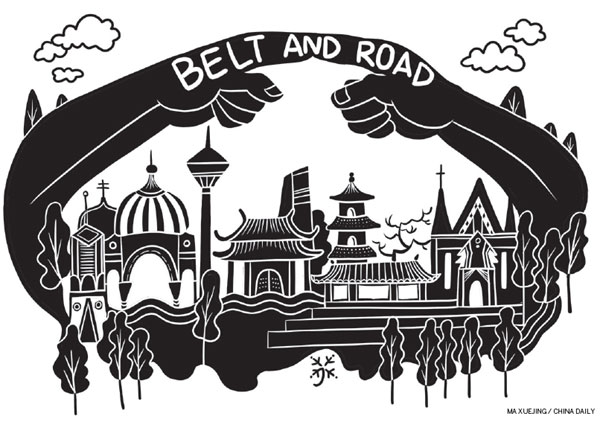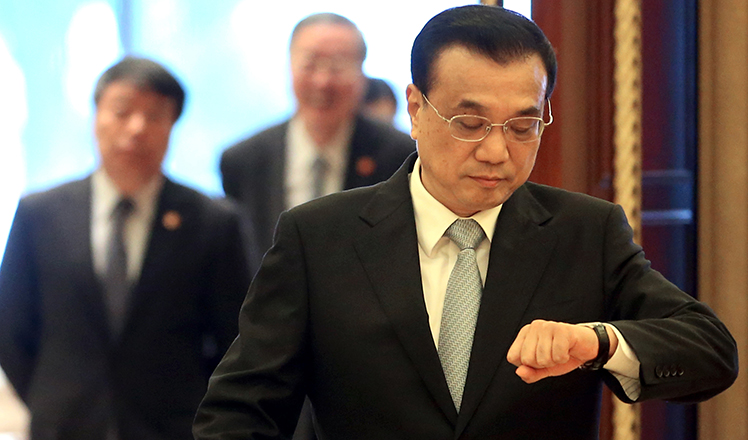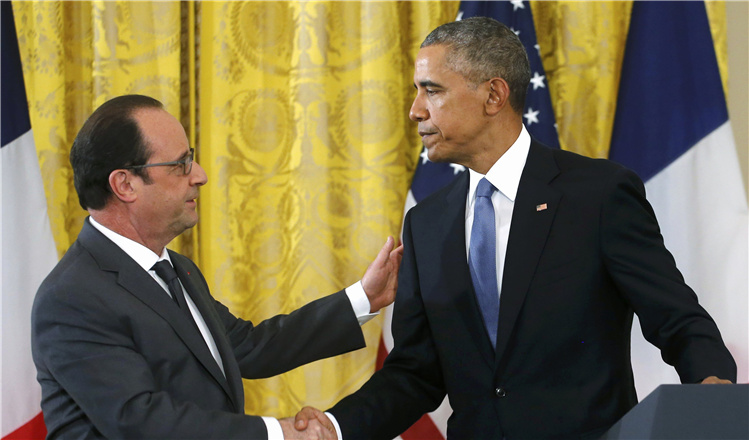Central, Eastern Europe's road to benefits
Updated: 2015-11-25 07:54
(China Daily USA)
|
||||||||
Editor's note: The fourth Meeting of the Heads of Government of China and Central and Eastern European Countries on Nov 24-25 holds a lot of promise. The following are some experts' opinions about how China's Belt and Road Initiative could benefit China and the CEE countries:
Align new Silk Roads with other European countries' plans
The year 2015 marks a defining moment in cooperation between China and Central and Eastern European countries, or "16+1 Cooperation", mainly for two reasons. The first is the Meeting of Heads of the Government of China and CEE Countries is held for the first time in China on Nov 24-25, and the second is the promotion of China's Belt and Road Initiative.
The 16+1 Cooperation ranked very high in China's foreign strategies in the context of the Silk Road Economic Belt and the 21st Century Maritime Silk Road (or Belt and Road Initiative).
CEE countries are located in the western part of the Silk Road Economic Belt, and China's proposal in 2012 to develop a framework of comprehensive mutual relations with these countries effectively signaled the beginning of the 16+1 Cooperation. Since then the 16+1 Cooperation has helped deepen mutual political trust, built cooperation mechanisms and frameworks, and developed practical collaboration among all parties.
China's government and enterprises have explored approaches to cooperation and identified the priority areas. In fact, China is now capitalizing on these experiences by drafting a mid-term "16+1 Cooperation Program". The country is also expected to seek additional opportunities for transnational infrastructure cooperation projects such as the Hungary-Serbia Railway and the extended network of China-Europe Land-Sea Express Line, as well as international industrial cooperation projects in the CEE region.
Compared with some areas in the grip of political and military conflicts along the Belt and Road, the CEE region is relatively peaceful and has stable markets. Still, China faces some challenges in pushing forward the Belt and Road Initiative in the CEE countries, the biggest arguably being how to deepen mutual political trust with the 16 countries and their global stakeholders.
China is trying to align the Belt and Road Initiative with the CEE countries' national development strategies to identify common economic interests, which will strengthen the mutual relations of these countries.
China is also making efforts to align the Belt and Road Initiative with the European Union's infrastructure development strategy, such as the Juncker Plan and the Berlin Plan, by proposing industrial cooperation with the EU in the CEE region. The alignment of the Belt and Road Initiative with the Eurasian Economic Union is aimed at dispelling any doubts Russia may have over China's initiatives, in order to brighten the prospects of China's cooperation with the Balkan states.
Coordination and cooperation in this diverse region is not easy to achieve. However, this challenging endeavor provides China with an opportunity to test and put to use its political wisdom and traditional philosophy of respect, inclusiveness and mutual benefit.
Liu Minru is an associate researcher in Central Compilation & Translation Bureau of the CPC and visiting scholar at the Institute for Security & Development Policy in Sweden.
Baltic states should seize initiative
The idea of reviving the Silk Road is one of the most formidable in recent years - it is difficult to imagine any other economic project that could compete with China's Belt and Road Initiative.
By announcing significant plans and allocating substantial funds for the implementation of the initiative, China has given 16 Central and Eastern European countries hope for a brighter future. Cooperation among the 16+1 countries in various fields - most importantly improved export-import opportunities and Chinese investments in the CEE countries - has been announced. While launching the Belt and Road Initiative, China has not only offered opportunities to countries, but also has undertaken considerable responsibility.
Many countries, including the three Baltic states, have placed huge bets on the potential investments China has promised to them. And figures show there is no need to worry as Chinese investment in Europe is growing, with the share of foreign direct investment constituting 6 percent and the growth occurring in the past few years.
In Latvia, for example, half of all Chinese investment since 1992 was made in 2013 and 2014. Last year alone, China invested 16.8 billion ($17.86 billion) in Europe, mostly in the countries in Old Europe. China indeed has huge funds to invest, but the recipient countries, at least for the time being, are unclear how they would be invested.
To cash in on the Belt and Road Initiative, therefore, countries wishing to cooperate with the still promising Asian market have to be more proactive. Countries do compete with each other. For instance, Latvia, Lithuania and Estonia do so even in their day-to-day affairs. But none of the three has been party to any international project on the scale of the Belt and Road Initiative, which offers cooperation in various fields, including culture.
The combined population of the Baltic states is barely more than 7 million, which is just a fraction of China's. So being part of the Belt and Road Initiative will be in the best interests of these countries. The same applies to other countries in Central and Eastern Europe, for they too have small populations compared with China's.
Most of the CEE countries, especially the Baltic states, are largely unknown to China despite regular reciprocal visits by leaders. Consequently, there is a risk that in the absence of initiatives by the Baltic states, the goodwill displayed by China will go to waste. Thus it is of utmost importance, regardless of whether they cooperate or compete, that the countries seize the initiative and offer their own ideas about how to encourage cooperation and friendship between China and the Baltic states.
Hopefully, such ideas will be voiced at the 16+1 meeting.
Katrina Iljinska is head of international relations of The Baltic Forum and consultant to the SDP "Concord" parliamentary group in Saeima, or the parliament of Latvia.
Poland is evaluating the wind of change
A lot has changed in the dialogue between China and Central and Eastern European countries since the first China-Central Europe-Poland Economic Forum was held in Warsaw on April 26, 2012. It was indeed a breakthrough, opening up a new era in relations between China and the CEE countries with 12 proposals put forward by China to promote cooperation with the 16 countries of the region with Poland at its core. The official establishment of the Secretariat for Cooperation for Central and Eastern Europe in Beijing - being first on the list - as a platform facilitating the implementation of the proposals followed in September the same year.
The meeting this year - the fourth overall and first to be hosted by China in Suzhou, Jiangsu province, is taking place at a particularly significant moment for Poland because of the recent change in government. The Polish delegation is led this time by newly elected President Andrzej Duda, which should make China view Poland as a significant strategic partner both on the political and economic fronts. Since the 16+1 meeting is held on the eve of the fourth anniversary of the strategic partnership between China and Poland, signed by previous Polish president Bronisaw Komorowski in December 2011, it calls for some reflections on the tangible achievements made so far, as well as raises questions about its future direction.
Without doubt communications between China and Poland have significantly increased over the last four years, through numerous political visits at the national, sub-regional and the European Union levels, people-to-people exchanges, flow of tourists, exchange of students and scholars and trade and cross border investments, which have contributed to better understanding and trust building between the two countries. This is an achievement of great importance.
But there are concerns over the significant asymmetry in bilateral trade, insignificant number of cross-border investments and the unclear role of China-led Asian Infrastructure Investment Bank in furthering the process.
However, expectations in Poland and other Central and Eastern European countries are high that the cooperation will not only be sustained, but also strengthened and more importantly transformed into real benefits through China's Belt and Road Initiative, the AIIB and the New Silk Road Fund.
As Napoleon once said, ability is nothing without opportunity. The abilities in the CEE countries have not been utilized for years. Let's hope, the emerging opportunities, initiated with the New Silk Road vision will start bearing fruits for China and Europe both.
Katarzyna Anna Nawrot is an assistant professor at the Poznan University of Economics and a member of the Commitee of Future Studies, Polish Academy of Social Sciences.
Strategic motivations at core of 16+1 initiative
Unlike the previous tao guang yang hui philosophy, or "hide brightness, nourish obscurity", China's present foreign policy is an assertive one. This self-confidence is reflected by the Belt and Road Initiative, the establishment of the Asian Infrastructure Investment Bank, its leadership role in BRICS, its strategic partnerships and the 16+1 cooperation mechanism.
As demonstrated by the "platform for connectivity" adopted at the China-European Union summit in June this year and the BRICS-plus format at the BRICS summit in Ufa in July 2015, the new Silk Roads are equivalent to bringing together countries and regions on a new track of cooperation for the benefit of all.
The 16+1 cooperation can be best understood if analyzed in today's global context. The world economy is undergoing tremendous changes, alongside shifts in the geopolitical and social orders. The pace of these changes has accelerated with the deeper and faster integration of the emerging economies into the global economy. The transformation of the "Arab Spring" into "Arab Winter", and the great divide between East and West over the Ukraine crisis and the accession of Crimea to the Russian Federation have increased the risk of geopolitical conflicts. Fragmentation has become the norm, while cohesion remains an ideal. Under these circumstances, China's initiatives appear as a driving force of integration starting from Asia, continuing with Europe and Africa and ending with Latin America.
For China, culture and foreign policy are its main "soft power" tools. The 16+1 cooperation literature underscores China has so far concluded more than 50 strategic partnerships with countries and groups of countries around the world. In Europe, its strategic partners are France, Germany, Italy, the United Kingdom, Spain, Portugal, Greece, Denmark, Serbia, Ukraine, Poland, Ireland and Belarus. Of the CEE countries in the 16+1 cooperation framework, only Serbia and Poland enjoy this status.
China's ties with the 16 CEE countries are not in the strategic partnership category. Scholars are still debating whether the 16+1 cooperation represents a "window of opportunity" or a "strategic opportunity". The literature also underlines that the 16 CEE countries are seen by China as a "bridgehead" to the EU, which could be used for "further economic expansion in Europe" and a "tool for building a positive image of China" in the region despite the rivalry between China, on one side, and Western Europe and the US, on the other that regard China as a "threat" to their established positions.
China's efforts to strengthen cooperation with the 16 CEE countries are comparable with BRICS' endeavours from an institutional standpoint, even though the economic and geopolitical scales of the two ambitious projects are incomparable. Through the first, China can gain influence in Europe. Through the second, it can expand its global role.
Therefore, this is a golden chance for the 16 CEE countries to transform this window of opportunity into a strategic partnership with China.
Iulia Monica Oehler-Sincai is a senior research fellow at the Institute for World Economy of the Romanian Academy.

(China Daily USA 11/25/2015 page12)

 Premier Li's fast-paced diplomacy
Premier Li's fast-paced diplomacy
 Obama: US, France stand united against IS, terrorism
Obama: US, France stand united against IS, terrorism
 Charming art made from everyday objects
Charming art made from everyday objects
 Ukraine sculptors set up workshop in China
Ukraine sculptors set up workshop in China
 Billionaire pays for $170m Modigliani with credit card
Billionaire pays for $170m Modigliani with credit card
 Crime stoppers meet in DC
Crime stoppers meet in DC
 Premier: China ready to advance Baltic Sea high-speed rail project
Premier: China ready to advance Baltic Sea high-speed rail project
 Beijing greets the sun after 19 days of gloom
Beijing greets the sun after 19 days of gloom
Most Viewed
Editor's Picks

|

|

|

|

|

|
Today's Top News
Chinese president arrives in Turkey for G20 summit
Islamic State claims responsibility for Paris attacks
Obama, Netanyahu at White House seek to mend US-Israel ties
China, not Canada, is top US trade partner
Tu first Chinese to win Nobel Prize in Medicine
Huntsman says Sino-US relationship needs common goals
Xi pledges $2 billion to help developing countries
Young people from US look forward to Xi's state visit: Survey
US Weekly

|

|